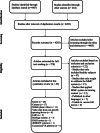A systematic review of the applications of markerless motion capture (MMC) technology for clinical measurement in rehabilitation
- PMID: 37131238
- PMCID: PMC10155325
- DOI: 10.1186/s12984-023-01186-9
A systematic review of the applications of markerless motion capture (MMC) technology for clinical measurement in rehabilitation
Abstract
Background: Markerless motion capture (MMC) technology has been developed to avoid the need for body marker placement during motion tracking and analysis of human movement. Although researchers have long proposed the use of MMC technology in clinical measurement-identification and measurement of movement kinematics in a clinical population, its actual application is still in its preliminary stages. The benefits of MMC technology are also inconclusive with regard to its use in assessing patients' conditions. In this review we put a minor focus on the method's engineering components and sought primarily to determine the current application of MMC as a clinical measurement tool in rehabilitation.
Methods: A systematic computerized literature search was conducted in PubMed, Medline, CINAHL, CENTRAL, EMBASE, and IEEE. The search keywords used in each database were "Markerless Motion Capture OR Motion Capture OR Motion Capture Technology OR Markerless Motion Capture Technology OR Computer Vision OR Video-based OR Pose Estimation AND Assessment OR Clinical Assessment OR Clinical Measurement OR Assess." Only peer-reviewed articles that applied MMC technology for clinical measurement were included. The last search took place on March 6, 2023. Details regarding the application of MMC technology for different types of patients and body parts, as well as the assessment results, were summarized.
Results: A total of 65 studies were included. The MMC systems used for measurement were most frequently used to identify symptoms or to detect differences in movement patterns between disease populations and their healthy counterparts. Patients with Parkinson's disease (PD) who demonstrated obvious and well-defined physical signs were the largest patient group to which MMC assessment had been applied. Microsoft Kinect was the most frequently used MMC system, although there was a recent trend of motion analysis using video captured with a smartphone camera.
Conclusions: This review explored the current uses of MMC technology for clinical measurement. MMC technology has the potential to be used as an assessment tool as well as to assist in the detection and identification of symptoms, which might further contribute to the use of an artificial intelligence method for early screening for diseases. Further studies are warranted to develop and integrate MMC system in a platform that can be user-friendly and accurately analyzed by clinicians to extend the use of MMC technology in the disease populations.
Keywords: Clinical measurement; Markerless motion capture; Rehabilitation.
© 2023. The Author(s).
Conflict of interest statement
The author(s) declare no potential conflicts of interest with respect to this article’ research, authorship, and/or publication that might be perceived to influence the results and/ or discussion reported in this paper.
Figures
References
-
- Corazza S, Mündermann L, Gambaretto E, Ferrigno G, Andriacchi TP. Markerless motion capture through visual hull, articulated icp and subject specific model generation. Int J Comput Vision. 2010;87(1):156–69. doi: 10.1007/s11263-009-0284-3. - DOI
-
- Rahul M. Review on motion capture technology. Glob J Comput Sci Technol. 2018;18(F1):23–6.
-
- Bonnechere B, Jansen B, Salvia P, Bouzahouene H, Sholukha V, Cornelis J, et al. Determination of the precision and accuracy of morphological measurements using the Kinect™ sensor: comparison with standard stereophotogrammetry. Ergonomics. 2014;57(4):622–31. doi: 10.1080/00140139.2014.884246. - DOI - PubMed
Publication types
MeSH terms
LinkOut - more resources
Full Text Sources


